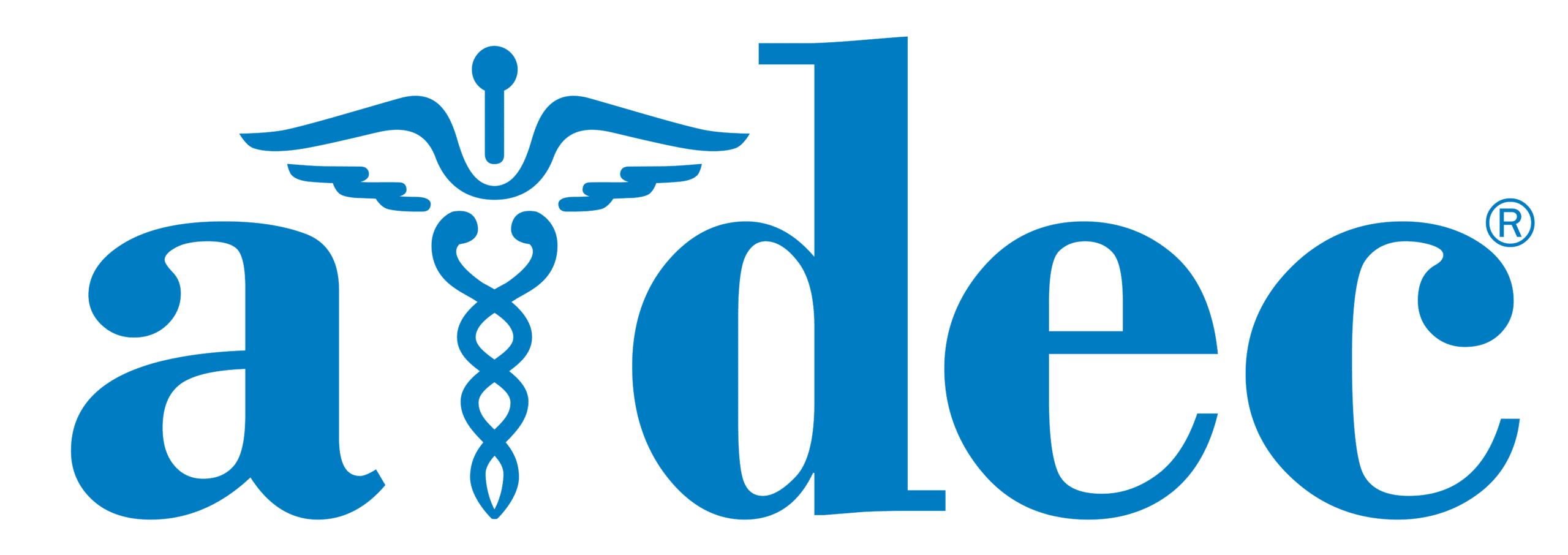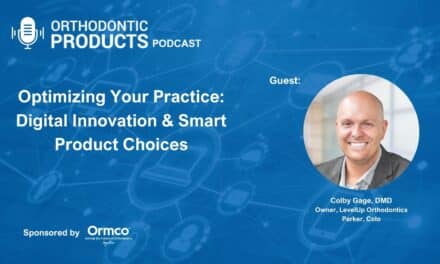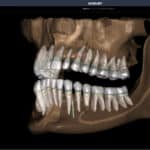Musculoskeletal pain is a common and often overlooked issue among orthodontic professionals. Long hours spent in static, repetitive postures can lead to chronic discomfort, fatigue, and long-term injury—affecting not only daily performance but also career longevity. In this episode of the Orthodontic Products Podcast, sponsored by A-dec, host Alison Werner is joined by Jeromy Moss, territory manager at A-dec and a certified ergonomics assessment specialist, to explore how thoughtful operatory design and the right equipment can prevent these issues and support better health for orthodontists and their teams.
Ergonomic Principles That Make a Difference
Moss explains that up to 70% of dental professionals—including orthodontic residents—report working in pain, often due to poor posture, improper seating, or operatory layouts that force unnecessary physical strain. Throughout the episode, he breaks down the key ergonomic principles that should guide the design of an orthodontic clinic—from how the doctor and team are seated, to how patients are positioned for optimal access to the oral cavity. According to Moss, the goal is to minimize large movements, such as trunk twisting or shoulder shrugging, and instead encourage efficient, controlled motions.
How Equipment Design Supports Better Health
The conversation also highlights the importance of adjustable equipment. From stools that contour to the user’s body type to patient chairs with flexible headrests and base positions, every detail plays a role in preventing the small but repetitive movements that cause fatigue and pain over time. Moss emphasizes that ergonomics benefit the entire team—not just the doctor—and that investing in these solutions now can pay off over a decades-long career.
Support for New Practice Owners
The episode also covers A-dec’s Smart Start program, which offers discounted pricing and long-term support for new orthodontic practice owners looking to outfit their space with ergonomic, high-quality equipment.
See A-dec at the AAO Annual Session
A-dec will showcase its ergonomic operatory solutions at the upcoming AAO Annual Session at Booth #3202. According to Moss, the booth will feature a complete orthodontic operatory setup, including stools, patient chairs, delivery systems, and cabinetry—each designed with ergonomics and efficiency in mind. Attendees will have the opportunity to explore how A-dec’s equipment supports better posture, reduces physical strain, and enhances workflow for the entire orthodontic team.
Key Takeaways:
-
Proper seating and patient positioning can significantly reduce physical strain.
-
Ergonomic equipment adjustments can improve comfort and extend career longevity.
-
Designing an operatory around movement efficiency benefits the whole team. OP
Podcast Transcript
Alison Werner (00:05)
Hello and welcome to the Orthodontic Products podcast. I’m your host, Alison Werner. Thanks for joining me today. Today’s episode is sponsored by A-dec and we’re diving into a topic that’s all about you, your health, your comfort and how the design of your clinical space can make or break both. We’re talking stools, patient chairs, delivery units and workstations and how ergonomic design plays a major role in preventing the aches, pains and long-term injuries that are far too common in the orthodontic practice. Here to walk us through it is Jeromy Moss, territory manager with A-dec.
Jeromy’s been with the company for nearly two decades helping orthodontists set up new offices and remodel existing ones. He’s also a certified ergonomics assessment specialist, which means he not only knows the equipment inside and out, but he understands how your habits and setup impact your productivity, your health, and your career longevity. Jeromy, great to have you on the podcast.
Jeromy Moss (00:53)
Great to be here. Thanks for the introduction. I appreciate that.
Alison Werner (00:56)
Yeah, so let’s get started with your certification. You’re an ergonomics assessment specialist. What is that training involved and how does that inform the way you support orthodontist as a territory manager for A-dec?
Jeromy Moss (01:09)
Sure. No, great question. So all A-dec territory managers are CEAS certified, which certified ergonomics assessment specialist. For me personally, and I think everybody else as well at the company, this is something very valuable, very important because it’s not just a certification that we just, we spent three days with a physical therapist specifically learning on how to assess a doctor in his or her team on
how they access the oral cavity, how they position themselves in their stools, how they position themselves as a team around that patient. So it’s very important, very valuable. So we really utilize it to assess the team. So it kind of depends. If they have a practice and they’re getting ready to maybe build a new building, for instance, we come in, we’ll assess them in their current space, and then talk about maybe the new space on what that’s gonna look like and how we can maybe
Alison Werner (01:45)
Mm-hmm. Yeah.
Mm-hmm.
Okay.
Jeromy Moss (02:07)
accommodate some of the things and some of the issues they’re having with accessing the oral cavity. But the CEAS is very important too, because if a doctor utilizes that certification that we have, ultimately it’s going to help them with feeling better five years, 10 years, 20 years at the end of the career. And I say this all the time, it’s not just the doctor, it’s the team as well I mean, doctors are, you the team is very important to the doctor. And they want to have a healthy staff.
Alison Werner (02:10)
Mm-hmm.
Mm-hmm.
Yeah.
Mm-hmm. Mm-hmm. Yeah.
Yeah, yeah.
Jeromy Moss (02:37)
healthy team.
how you get that access to the oral cavity is very, very, very, very important to him.
Alison Werner (02:44)
Yeah, yeah. Yeah. So okay, so
since you’re working with a lot of orthodontists and their staff, and you come across them at different stages in their careers, what are some of the most common pain points literally that you hear about? Is it neck strain, shoulder pain? What are the day to day movements or habits that are usually to blame?
Jeromy Moss (03:05)
for, you know, statistics show to go along with this question that doctors are 65 to 70 % in some form of pain, working in some form of pain or with pain, I should say. Hygienists, which orthodontists actually sometimes have a hygienist that will come in and do some cleanings. 70 % of hygienists work in with some form of pain. And then a staggering statistic, and I have several dental schools in my territory.
Alison Werner (03:16)
Yeah.
Yeah.
Mm.
Yeah.
Jeromy Moss (03:31)
third
year dental students before they’re even out in the real world, so to speak, already are in 70 % of them are in some form of pain. So what I say to that all the time, and I’m gonna get to your question, I promise, is it’s very, very important as a young practitioner to start off with good habits, right? So as they grow in their career, they feel better at the end of the day.
Alison Werner (03:36)
huh.
okay.
Mm-hmm.
Yeah.
Yeah,
absolutely.
Jeromy Moss (04:00)
But I would 100 % say when you, so the CEAS certifications, even maybe go back to the question you had, what I do a lot of is I’ll get asked to come in. Dr. Alison, let’s just use your name. You want me to come in. You want me to watch you and your team work. Because maybe you’re having some serious issues and some of the staff members, team members are having some issues with their pain. And so I’ll watch from the hallway and literally just watch you work chair side with you and your team. And then.
Alison Werner (04:06)
Yeah.
Mm-hmm. Mm-hmm.
Mm-hmm.
Jeromy Moss (04:29)
maybe after two hours or so kind of observing, we’ll get together at the end of the day, or maybe it’s before lunch that I’m watching you and at lunch we’ll get together and talk through that and really watch at really what I’m looking for is, is, is class movements. Okay. And what I mean by that is, if I don’t mind, I’ll explain this real quick. Ones are fingers, twos are wrists, threes are elbows, fours are like shoulder shrugs. If we’re like trying to go and get to the oral cavity.
Alison Werner (04:37)
Mm-hmm.
Okay. Yeah, go for it.
Okay. Yeah.
Jeromy Moss (04:59)
And then fives are big trunk rotations. Like if we’re constantly twisting our bodies to go grab something and then come back to the prep to the, whether it’s the work surface or whether it’s the patient. So the more that we can stick with one twos and threes and the less of like the fours and fives, the big trunk rotations, the better. So with that CEAS certification, I come and look for that. Like, Dr. Alison and team members, we’re doing a lot of like bending over to go grab things like.
Alison Werner (05:02)
Okay. Okay.
Mm-hmm.
okay.
Okay.
Yeah.
Jeromy Moss (05:28)
We need to figure out how to bring those up closer so they’re minimal reaches. Does that make sense? So to go with the question you just asked, if we’re doing a lot of shoulder shrugs to get to the oral cavity, we’re really trying to get tall to get to oral cavity, we’re gonna feel that in our upper neck muscles, right? If I’m leaning out over the patient, constantly trying to get vision to the oral cavity, my upper neck muscles, because my head
Alison Werner (05:33)
Mm-hmm. Yeah. Yeah.
Right.
Yeah, okay.
Jeromy Moss (05:57)
head is gotta have a forward head carriage, my head starts multiplying, doubling as far as weight when I start protruding it out over my shoulders. So see a lot of neck pain, lot of shoulder because we’re doing that forward head carriage looking to get access and vision to the oral cavity. So what we try to teach and we don’t just try to teach it, we build product to it and I know we’re gonna talk about that here in a little bit.
Alison Werner (05:58)
Yeah, right.
Mm-hmm.
Hmm.
Yeah.
Yeah.
Jeromy Moss (06:24)
on how do we get better access so that we can adjust our patient to me as a practitioner or yourself and your team members. If we have a product, whether it’s the patient chair or the stool or even the, the console that the, it’s called an orthopedic. How do we make sure that a, we can adjust the patient to us and not us to the patient, but bring the patient’s oral cavity to us, right? That’s crucial, but it really starts with the dental seating for the practitioner.
Alison Werner (06:30)
Mm-hmm. Right.
Yeah.
Mm-hmm.
Jeromy Moss (06:55)
they have to sit properly in their stool, chair side, and then introduce the patient to themselves. So it really starts. talk a lot about it starts with me as a practitioner sitting myself properly and then bringing that oral cavity to me versus me to that point. But as far as pain, I’m sorry, as far as pain, see a lot of, you know, when they compensate, it’s a lot at the hips and then it’s a lot of the head, right?
Alison Werner (06:58)
Right.
Mm-hmm.
Okay. Yeah, go ahead.
okay.
Jeromy Moss (07:22)
So
we really got to work on like, we need to sit, you know, get ourselves properly positioned and sit better.
Alison Werner (07:28)
Okay, going on from that, talk to me about how the right equipment, the right stool, the right patient chair can help with that.
Jeromy Moss (07:41)
Sure. again, starting at the stool, because that’s where it starts, we need we have a stool that accommodates anybody’s body type. OK. And so what I mean by that, we’re all built differently as humans. Right. We all have different sit bones and different thighs and different torsos and things like that. So if you have a stool that’s kind of
Alison Werner (07:44)
Okay.
Mm-hmm.
Right.
Jeromy Moss (08:02)
not a one size fits all and you know you and I try to sit in that same stool maybe it doesn’t adapt to myself like it does to you does that make sense? So our stool no matter who sits in it it’s got a flex frame that actually gives and kind of contours to everybody’s different body types and body shapes so it’s going to allow each practitioner to sit in that stool properly and there’s some education that comes with that and how to use it properly.
Alison Werner (08:04)
Mm-hmm.
Right. Yes.
Okay.
Yeah.
Jeromy Moss (08:31)
And then it allows back rest adjustments and movements with a push of a tap. So we have a stool and there’s a lot of stools on the market. I just educate towards our stool. But we have a stool too that is a very older product for us that had a knob. So a knob, you adjust it when you first get it. And then you probably don’t adjust it for the next 20 years. Like it’s too cumbersome, right?
Alison Werner (08:44)
Yeah.
Okay.
True. Yeah.
Mm-hmm.
Jeromy Moss (09:01)
The stool we have now, big improvements on our previous stool, it’s a push tab. So literally you could push a tab and you can make these adjustments in seconds. So why is that important? Well, let’s say you have an office that has a six foot doctor, okay? And then I’m the assistant that’s five two. There’s big variances, big variables on how you’re going to position yourself.
Alison Werner (09:16)
Mm-hmm.
Right? Yeah.
Yeah.
Jeromy Moss (09:26)
And if a doctor that six foot can come in and make those quick adjustments in seconds, then shame on them for not using it, if you will. But a knob, they’re not going to adjust it and they’re going to just accommodate. So the stool is where it starts. And then that the patient chair, you have to sit a patient properly. And so, Alison, I spent a lot of time on this when I sell, when we, when the doctor makes the purchase.
Alison Werner (09:31)
Mm-hmm. Right.
True, Okay.
Mm-hmm.
Jeromy Moss (09:53)
on the product.
We come in and we do an equipment orientation. So when they partner with us, we come in and spend a lot of time, a couple hours, two hours with the staff and the team members on, you have the best product on the market. We got to make sure we’re utilizing it to its fullest potential. And so when picking a chair, patient chair, we believe, and I believe, that it’s very important that there’s those adjustments to be able to sit different sized patients.
Alison Werner (10:09)
Mm-hmm.
Mm-hmm.
Jeromy Moss (10:23)
in the patient chair, right? Because what we see a lot of is if the headrest stays touching the backrest and we’re not adjusting the headrest up to accommodate a taller patient, that patient is going to slouch down in the chair wherever that headrest is, okay? And bear with me, this is gonna make sense here in a second. And if we make everybody like a five, two patient, cause they slouch down in the chair,
Alison Werner (10:25)
okay. Okay.
Mm-hmm.
Okay, yeah.
Mm-hmm.
Jeromy Moss (10:52)
The shorter the patient, the harder it is to get access to oral cavity because you do have to roll up underneath the backrest no matter whose product there is. If we extend the headrest up and we extend the patient to their true size, we actually can get better access to oral cavity. So it even starts with just setting the patient properly. The second thing is we, I firmly believe there’s a lot of product out there in the ortho space, orthodontic space that
Alison Werner (10:59)
Okay.
Mm-hmm. okay.
Mm-hmm.
Jeromy Moss (11:20)
Only the backrest has adjustments. Okay, so you can lay a patient back and then you bring the patient forward. Well, I firmly believe that having a base adjustment as well is going to be beneficial and helpful to the overall success of that practitioner and his or her team. Because again, if I’m six foot, I’m gonna need that base to be able to raise higher so I can roll up underneath it and not leaning over.
Alison Werner (11:26)
Mm-hmm.
Right. Yeah.
so you’re not leaning over, right?
Okay.
Jeromy Moss (11:48)
Maybe you’re shorter at five, two or five foot. Well, I want that chair to go even lower so that I can sit in my stool and I have to raise my stool super tall to get up to that taller base, if that makes sense. having those movements and adjustments, again, to be able to adjust the patient to my height as a practitioner or team member is very, very crucial.
Alison Werner (11:51)
Mm-hmm. Mm-hmm.
Right.
Mm-hmm.
Yeah.
What would you say to an orthodontist or a team member who’s like, I can’t do all those adjustments for every patient for every chair?
Jeromy Moss (12:23)
question. Great. Sorry, were you done? didn’t mean that. I thought I was so excited. I wanted to jump in and answer that question. Great question. Because here’s what I say. So, and if I don’t mind, I’m going to back up just a tad. So I graduated school with exercise science sports medicine degree. Okay. I was actually thinking about going to be a physical therapist and did my internship in South Bend, Indiana.
Alison Werner (12:25)
Yeah, no, that’s it. That was the question.
Jeromy Moss (12:50)
but realize that’s not what I wanted to do the rest of my career and it’s a great profession. So a lot of the things that I learned in school is a lot of what we talk about chair side. So to answer your question, I say this all the time, Alison, let’s pretend you’re the team member. You work at the practice, okay? You’re here for eight hours a day, four days a week, or whatever that particular office schedule is, right? I’m here as a patient.
Alison Werner (12:59)
Okay.
Mm-hmm.
Yeah.
Jeromy Moss (13:20)
depending on what they’re doing, maybe 20 to 45 minutes, depending again on what they’re doing. So if you’re here eight hours a day, adjust that patient to you, right? And have them do certain things. Even sometimes Alison, it’s like, hey Jeromy, move your chin to the right or move your chin to the left while they’re in the patient chair, because that’s gonna help me be able to see a little bit better when you’re working on my oral cavity.
Alison Werner (13:27)
Right.
Mm-hmm.
Jeromy Moss (13:50)
but yes, a hundred percent like Alison, you know, I hear what you’re saying and you’re like, Hey, it takes me a couple of seconds to adjust the patient. But what I always say is this, whether it’s me in my truck and vehicle driving for eight hours around my territory, I feel it towards the end of the day. start feeling a little tired, right? We all do in our job. So adjusting that oral cavity to you and taking the extra couple, you know, call it five, 10 seconds to make that adjustment.
Alison Werner (13:59)
Right.
Mm-hmm. Mm-hmm. Right. Mm-hmm. Mm-hmm. Mm-hmm.
Jeromy Moss (14:21)
At the end of the day, you’re going to feel less fatigued because you’re not going to hold some of these postures that if you’re trying to lean out over the oral cavity, you’re going to start feeling that, right? So if you take an extra 10, even 20 seconds and bring the patient to you, I promise you, you will feel better at three o’clock, four o’clock in the day than if you don’t do that. And then I always jokingly say, hey, we all go to lunch and eat our turkey sandwich and we start kind of feeling sluggish, right?
Alison Werner (14:26)
Yeah.
Right. Yeah. Yeah.
Mm-hmm.
Yeah.
Uh huh.
Uh huh.
Jeromy Moss (14:51)
And
so make those adjustments because it will 100 % help you feel better towards the end of the day and again, towards the end of a career. So take that time.
Alison Werner (14:59)
Yeah, well, and if you’re talking
and if you’re saying that like, res, third year residents are already feeling it, then what does that mean for a 20, 30 year career? You know?
Jeromy Moss (15:04)
Yeah.
Yes.
So, and I think too in the orthodontic world, I think it’s even more challenging and I’m not by no means a practitioner. So I’ve not done this job, but I’ve observed a lot of it for 20 years is what I’ve been doing. But I think because, know, there’s so much, especially when they’re doing all the bands and taking off brackets, I mean, there’s a lot of…
Alison Werner (15:15)
Mm-hmm.
Yeah.
Jeromy Moss (15:35)
Not that the other professions and the other specialties aren’t challenging as well because the other day everybody’s still trying to get to access to oral cavity, right? But I feel like even in the orthodontic world. It’s even I would say even it seems like it’s more challenging as well so
Alison Werner (15:38)
Yeah.
Right, yeah.
Okay.
So talk to me, given that you just said like, you know, orthodontics is a little bit different. Orthodontics isn’t in general dentistry. Is there a meaningful difference between the equipment designed for a dental practice and that design for an ortho workflow?
Jeromy Moss (16:09)
Sure. So I would say that stools same across any specialty. To me again, I think the chair is very comfortable as far as the patient chair, right? To be able to get access to the maxillary and the mandible and be able to adjust the patient’s head. I think the biggest difference though, and you bring up a good point, is the orthopedistal, which is kind of like the side console, right? That sits kind of to the right or to the left of the chair, depending on.
Alison Werner (16:34)
Okay.
Mm-hmm.
Jeromy Moss (16:39)
left-handed, right-handed
Alison Werner (16:40)
Mm-hmm.
Jeromy Moss (16:41)
kind of mentality. But I think that that’s the biggest difference. And why that is is they want a lot of drawer storage, then they want a pretty good size work surface that is right there, right to the right of the patient, if they’re kind of a right-handed mentality. Obviously, it’d be on the left side for left-handed mentality. But they have a lot of…
Alison Werner (16:58)
Mm-hmm. Yeah.
Jeromy Moss (17:05)
material
products that they’re kind of spreading out on this orthopedistal. And that’s a little bit different from a standpoint of general dentists. It’s more behind the patient. Okay. So in orthodontic worlds, it’s right next to the patient. So there is a difference on how they access and how they
Alison Werner (17:09)
Okay.
Mm-hmm.
Okay.
Mm-hmm.
Jeromy Moss (17:29)
if you will, that problem.
Alison Werner (17:29)
Okay,
okay, which is going to come into play with the movement of the trunk, the shoulders, the neck.
Jeromy Moss (17:38)
Yeah. The class fours and fives exactly. Right. So if, them, you know, when we lay out a space and we’re working with our dealer partners and our equipment specialists, and we’re teaming up on how are we going to lay the space out, it’s very important, especially in the orthodontic world to, to make sure that we’re placing that orthopedistal in a very accessible. So we’re not having to like reach forward and grabbing things.
Alison Werner (17:40)
Right, okay, okay.
Mm-hmm.
Jeromy Moss (18:05)
But when we’re sitting chair side at the oral cavity, it’s just really very easy to pull out a drawer and it’s kind of right there accessible. That makes sense.
Alison Werner (18:13)
Yeah, yeah, yeah,
yeah. Okay, so let’s talk about A-dec. What makes A-dec’s equipment and furniture kind of stand out in the ortho space? You’ve talked a little bit about there, but I wonder if you can go a little more in depth and how does the company approach kind of the unique needs of the ortho team?
Jeromy Moss (18:19)
Yes.
Good.
Yeah.
So if you don’t mind, I’d like to first start off by talking about our quality. Because no matter what, it needs to last, right? The product, and we believe the quality of the product, A-dec is well known for quality in the market. And I say that with humbleness, but we do try to build a product that’s going to last 20 plus years for that office. And a lot of times I see product, I’ve been doing this for 20 years now, it’s 30 years old.
Alison Werner (18:38)
Yeah.
Mm-hmm.
Yeah, okay.
Hmm.
Jeromy Moss (19:02)
Quality
first and foremost is crucial to what we do at A-dec. Second thing is it’s gotta have function. So that product, we don’t just build something just to make it look pretty and neat and nice. Yes, that’s also part of it, but we have to have function. Okay, so at the end of the day, if it looks neat and nice and it doesn’t support a chair side, it doesn’t support.
Alison Werner (19:18)
Mm-hmm.
Mm-hmm.
Jeromy Moss (19:31)
and have good function to be able to support us when we’re working on the oral cavity, then I don’t want to say so what, but it needs that function. Some of the other things that I would say with A-dec, not only just the quality, the support. So when doctors buy and build a new office, let’s say you’re getting ready to build this new office, you’ve been working for a couple of years, you’re ready to do your first practice, we’re very much,
Alison Werner (19:33)
Mm-hmm. Mm-hmm.
Yeah.
Mm-hmm. Mm-hmm.
Jeromy Moss (19:59)
And I think hopefully this kind of speaks to the equipment as well. It’s not just we sell a product. Like I say this all the time, we’re gonna be a part of your practice. I’m gonna come back even in two years. You wanna redo a new assessment and reassess on how we’re working with the product. I’ll come back two years, five years down the road. I’m gonna be part of the practice for the rest of your career. Some of the other things I would say the A-dec does I feel a little differently is again,
Alison Werner (20:04)
Yeah.
Mm. Okay.
Okay, yeah.
Jeromy Moss (20:29)
We don’t just sell the products and say goodluck. We support it. We support it with Superior Customer Service and tech support. And then we do things like ICV, which goes into our product, ChairSide. What that product does, it actually cleans the lines. suction lines, right? So they have to obviously have suction. And that product’s built into the actual orthopedistal.
Alison Werner (20:43)
Mm-hmm. Mm-hmm.
Okay.
Yeah. Yeah.
Jeromy Moss (20:58)
So they don’t have to go back to sterilization and grab a bucket and come out and clean. It’s right there on chair side. They pop it on, they can clean it. They could even clean it in between patients if they had to or if they wanted to. there’s other things that seeing my product at one of our display floors or at a show, it’s easier to kind of talk to. But we do several things to ultimately try to help the doctor and his or her team be more efficient and have better health and better posture.
Alison Werner (21:03)
Mm.
Okay. Okay.
Mm-hmm. Yeah.
Yeah. You mentioned orthodontists that are just kind of getting started. I know A-dec offers the Smart Start program. Can you tell us a little bit about what that is and how it helps those doctors who are opening their first practice?
Jeromy Moss (21:39)
Sure. So several years ago, we started this program called, like you mentioned, Smart Start Program. What that entails is ultimately, and I always suggest, obviously connect and talk to myself about, there are certain qualifiers that are involved with this program, but ultimately the program is 25 % discount for two years. And I think it’s very crucial to kind of mention that. know, sometimes,
Alison Werner (21:52)
Mm-hmm.
Mm-hmm.
Jeromy Moss (22:08)
You know, these doctors are excited. They’re getting ready to go start their first practice, maybe after being an associate for a couple of years, they want to go do their first building and their first practice. Well, there’s a lot involved in that, a lot of expenditures, lot. There’s, there’s, there’s, you know, money that it takes to do that. So what we do at A-dec is try to help with that and say, okay, for the first two years, so you don’t have to go do it all up front, right? You got, you got, there’s quite a few things going on as far as
Alison Werner (22:23)
Yeah. Yeah.
Okay, good point.
Jeromy Moss (22:37)
costs involved in doing your first practice.
So you have a two year window to be able to grow as you grow. So you don’t have to go outfit all 10 operatories or, eight operatories or whatever it may be. And you start off with the minimal qualifiers and then you grow as your practice grows and we grow with you and we give that for first two years. Then on top of that, Alison, there’s another two additional two years. So you’re three and four.
Alison Werner (22:49)
okay. Yeah.
Mm-hmm.
Bye bye.
Mm-hmm.
Jeromy Moss (23:07)
you actually have additional discounts. So it’s called the clinic discount. I won’t explain all that, but I guess ultimately a four year discount program to help those doctors that start off their first practice to grow with them. And they have four years to take advantage of those discounts. And one other thing, sorry, one other thing, we also partner with Hu-Friedy, so well known with its…
Alison Werner (23:10)
Okay.
Yeah.
Okay, Yeah, everything.
okay. Mm-hmm. Yep.
Jeromy Moss (23:35)
Um, they, if you’re a smart start qualifying doctor, and we’re very close to with our, Hu-Friedy reps, they would actually connect with us. Hey, Dr. Alison has mentioned. She’s a smart start program doctor. We approve that and, you know, make sure that that, is the case, not that anybody’s trying to, make sure that it is case. then Hu- Friedy actually offers deeper discounts with smart start, uh, qualifying doctors as well, but there’s not offered anywhere else on the market. So they also.
Alison Werner (23:51)
Right.
Jeromy Moss (24:05)
play with that program, play with that program as well. And then the last thing is Ascent Marketing, which is pretty well known in the industry. They have a program that also is paired with our Smart Start program, where it is only offered to Smart Start program doctors as well. So there’s a kind of a bundle of some experts, if you will, that participate in that program.
Alison Werner (24:27)
Yeah. Mm-hmm.
Okay. Well, before we wrap up, the AAO Annual Session is coming up and A-dec will be there. So what can attendees expect when they kind of stop by your booth?
Jeromy Moss (24:41)
Sure, yes. So come by and check us out. We’re at Booth Space 3202. I will unfortunately not be there, but there will be some awesome A-dec-TMs there to show off the product and talk to any doctors that might have any questions. But they basically are going to have a pod, if you will, of an ortho-designed orthopedistal, one of our chairs, stools. There are also, and I didn’t mention this, we also have mechanical.
Alison Werner (25:08)
Yeah.
Jeromy Moss (25:10)
equipment as well. So the compressor that would support the unit chair side, right? And then the vacuum that’s, you know, going to get rid of fluids in the mouth or oral cavity. But yeah, they’ll have that setup, a mock setup of what orthodontic operatory would look like. And they’d love to talk to you. I’d love to show you it off. Love to explain some of the things in greater detail that I kind of was talking about that can actually show you
Alison Werner (25:11)
like. Okay.
Mm.
Yeah.
Jeromy Moss (25:39)
Some of the whys behind the product and how you truly can get better access to the world cavity with what we
Alison Werner (25:41)
Mm-hmm.
Great. Well, Jeromy, thanks so much for being here and for kind of shedding light on this aspect of the practice that I guess kind of gets overlooked until it starts causing problems. So thank you for this.
Jeromy Moss (25:57)
Yes, and like I said, I’m passionate about this. Like I do, come in and I’ll say, we can change some lives. And I might just say that, I truly mean that, I guess is what I should say. When we can show doctors with our product and how it can totally change the way they sit chair side, it’s a game changer. And I would say this, people who are in pain and unfortunately kind of like the statistics that I shared earlier.
Alison Werner (26:00)
Yeah.
Mm hmm. Yeah.
Yeah.
Jeromy Moss (26:25)
There’s
a lot of the people that we talk to and work with, they’re in pain. If we can help them get out of that pain, it’s beautiful thing. So love what we do. Thank you so much for the time. And I love, love, you know, just being on this podcast and if we can help out with anything, please get with your local A-dec TM. If you don’t know who that is, you can always call our 800 number at 1-800-547-1883. They’ll help you.
Alison Werner (26:30)
Yeah, yeah, yeah, absolutely. Thank you.
Jeromy Moss (26:54)
or you can go to www.a-dec.com and there’s a link that you can put your zip code in and it’ll tell you and give you information on who’s your local TM, A-dec TM.
Alison Werner (27:05)
Great.
Sponsored by














